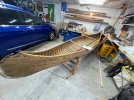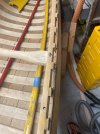Skiboy127
Curious about Wooden Canoes
I recently acquired an OT yankee serial 92332. This project is gonna be slow going but I have a few questions before I start.
First construction wise I can’t tell what the build sheet says the decks were made of the word looks like “Buick” but that can’t be right…
Second I need to repair/replace the stern stem, is this white cedar like the rest of the ribs and deck or ash like the thwarts look to be?
Third is the biggest stumper to me, there are three holes in the inwhales forward of the bow seat on each side and one larger hole behind the bow thwart on each side that look similarly weathered to the rest of the boat but I have no clue what they would have been?
Finally I have pretty good access to wood but have no clue where to look for boat tools (specifically a clinching tool) and hardware like copper deck nails
Thanks for the advise in advance
First construction wise I can’t tell what the build sheet says the decks were made of the word looks like “Buick” but that can’t be right…
Second I need to repair/replace the stern stem, is this white cedar like the rest of the ribs and deck or ash like the thwarts look to be?
Third is the biggest stumper to me, there are three holes in the inwhales forward of the bow seat on each side and one larger hole behind the bow thwart on each side that look similarly weathered to the rest of the boat but I have no clue what they would have been?
Finally I have pretty good access to wood but have no clue where to look for boat tools (specifically a clinching tool) and hardware like copper deck nails
Thanks for the advise in advance






